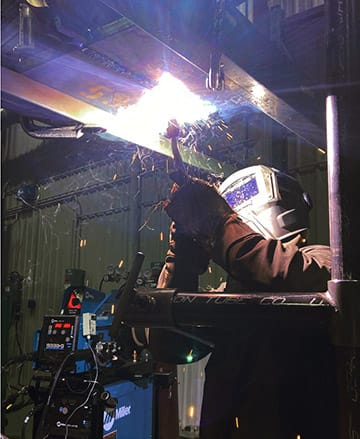Everything You Need To Know About Weld Slag (And Why You Should Know It)
Welders may know slag as a bothersome byproduct of gas-shielded and self-shielded flux-cored processes, since it frequently requires chipping or grinding to remove it after welding or in between passes. But slag is much more than that. It plays an important role in ensuring good weld quality and the various slag systems also impact a wire’s welding characteristics.
So, what exactly is slag and what does it do?
Slag by definition, purpose and chemistry
The American Welding Society (AWS) defines slag as “a nonmetallic byproduct of the mutualdissolution of flux with nonmetallic impurities in welding and brazing processes.” In short, it is the hardened layer left on the top of weld made during flux-cored welding (FCAW). It is also present in shielded metal arc welding (SMAW), submerged arc welding (SAW) and other welding and brazing processes and can have a slightly different makeup depending on process or product.
Removing welding slag is a mechanical process, completed with chipping hammers, wire brushes or wheels, or needle scaler. Some filler metals, however, are formulated with self-peeling slag that releases from the weld on its own.
Slag’s purpose is two-fold. It protects the weld from oxidation and contamination from the atmosphere. It also helps keep the molten weld pool in the joint as it cools, which is especially important for out-of-position welding.
Slag forms when the heat from the arc breaks down the filler metal and the base material to form a molten weld pool. Through thermodynamic processes, elements that are not included in the formation of the weld pool are essentially pushed out and forced to the surface. There, the elements solidify into slag that includes nonmetallic elements, such as oxides of aluminum, silicon and calcium oxides, and may also pull nitrogen, hydrogen and some carbon out with it.
The flux inside of both gas-shielded and self-shielded flux-cored wire impacts the way slag behaves. For example, wires with higher levels of titanium dioxide (TiO2) have a faster freezing slag, which makes the wire better for welding out of position. However, too much titanium can make the slag sticky. Further, wires with higher levels of silica tend to generate a slag that is more difficult to remove, while those with higher levels of lime have slag that is easier to remove.
Slag systems and their characteristics
Flux-cored wires are available with rutile (acidic) or basic slag systems, each of which impact the weldability of the wire, including arc performance. Each system also has its advantages and limitations.
Rutile slag systems are composed mostly of titanium dioxide from the mineral rutile, along with other minerals, such as silica, alumina or zircon. Wires with a rutile slag system have good weldability with low spatter and a soft arc. They are considered to have excellent welder appeal, since they are easier to use than flux-cored wires with a basic slag system, particularly out of position. But, wires with a rutile slag system do not offer as good of mechanical properties to achieve low temperature toughness compared to their basic counterparts. Wires with a basic slag system are composed of minerals of alkali elements, such as fluorspar, limestone, magnesite or dolomite. Basic slag systems are highly effective at lowering weld metal oxygen, providing superior weld metal toughness but low freezing temperature slags.

self-peeling slag that releases from the
weld on its own.
Some of the most common flux-cored wires with rutile slag systems include those classified under AWS A5.20: Specification for Carbon Steel Electrodes for Flux-Cored Arc Welding and feature designators of T-1, T-9 and T-12.
T-1 flux-cored wires provide good wetting action and are generally reserved for less critical applications since they don’t offer the best toughness. T-9 wires have to meet the same chemistry requirements as a T-1, along with additional requirement of 20 ft. lb. at -20°F for their Charpy V-Notch testing. T-12 wires are very similar to T-1 and T-9 wires, but they have been modified to provide similar or better impact properties than the T-9. They also have lower manganese content, which allows the wires to meet the requirements of ASME Section IX for boiler and pressure vessel welding. They tend to require the base material to be relatively clean to achieve X-ray quality.
Basic slag systems are made up primarily of limestone, particularly calcium carbonate (CaCO3), which helps provide good impact properties at low temperatures. This slag system also offers a low-hydrogen weld deposit to provide excellent resistance to hot and cold cracking. Many T-5 wires are limited to flat and horizontal welding positions. Overall, they are more prone to generating spatter and are consider less welder-friendly than flux-cored wires with a rutile slag system.
Preventing welding slag inclusions
Welding slag inclusions can affect the quality of welds produced with flux-cored processes and occur when the slag becomes trapped in the weld when it solidifies. There are several best practices and techniques to help minimize this risk.
First, always fully remove the slag after welding during multi-pass welds to prevent it from being trapped inside the weld during subsequent passes.
During flat and horizontal welding, use a drag technique with a gun angle of zero (straight up and down) to 10 degrees. The technique for vertical up may vary according the gas- or self-shielded flux-cored wire being used. A drag technique still works well for vertical-up welding if the wire produces a heavy slag. For T-1 wires in a vertical weld, typically a zero-degree travel angle will produce quality bead shapes.
For other wires, such as T-5 wires, a zero-degree travel angle, to a slight push (around 5 degrees) works, since this technique puts more heat into the base material, allowing the slag to come to the surface of the weld pool.
Using the right welding parameters and travel speeds are also key to reducing the risk of slag inclusions. Too fast of travel speeds or too high of current (which directly effects wire feed speed) can lead to a convex bead profile with dips at the toes of the weld where slag can be locked in place. Too low of current can result in the same problem.
Too high of voltage tends to make the weld bean more concave, which can sometimes lock slag into the weld as well.
Following best practices
As with any welding process, selecting the right flux-cored wire for the application and using it according to the filler metal manufacturer’s recommendation is key to gaining good welding performance. Knowing the slag type associated with each wire is also important to understanding the wire’s weldability and the amount of post-weld and interpass cleanup that will be required. Always follow cleaning best practices to avoid inclusions that could lead to downtime and, potentially, costly rework.
Related Articles:
Quality Matters: How to Get a Quality Weld that Really Lasts
Electroslag Strip Cladding Offers Productivity and Cost Benefits



